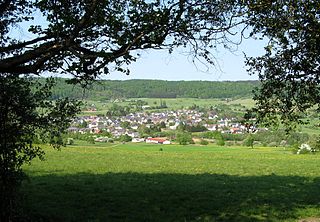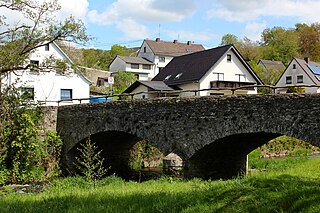The castle and the town
The castle (Schloss), former seat of the Counts of Sayn, was founded about 1180 by Count Heinrich II of Sayn.
Building was finished in 1212 under Count Heinrich III, the founder's son, who was also mentioned as the town's and the castle's first owner. At the same time, under the Count's overlordship, came the building of the neighbouring Marienstatt Cistercian Monastery.
In 1314, Hachenburg, whose name comes from a castle hill protected by thornbushes, was granted town rights. The original settlement lay not on the 390-m-high castle hill, but rather some 1.5 km away in the dale about 100 m lower through which runs the Rothbach, on the site of what is now the outlying constituent community of Altstadt (which explains its name – Altstadt is German for “Old Town”), which had its first documentary mention in 1343. The Romanesque St. Bartolomäuskirche, built there about 1200 and nowadays an Evangelical church is Hachenburg's oldest preserved building, followed by the Steinernes Haus (“Stone House”), known as Zur Krone, from the 15th century, at the Old Market (Alter Markt) in the town centre. The castle church only arose in the late 15th century and underwent several remodellings until the 18th century. The Catholic Church of the Assumption of Mary, from the early 18th century, belonged at first to a Franciscan monastery, but later, in 1813, became the parish church. In the Middle Ages, the town's population was most likely never more than about 500 to 1,000, and in the 17th and 18th centuries it was between 1,000 and 1,500. Only after the Second World War did this small town's population reach first 3,000, and nowadays almost 6,000.
On 13 October 1654, there was a great town fire in which not only did a great deal of the inner town burn down, but also the castle. Counts Salentin von Manderscheid and Georg Friedrich von Sayn-Hachenburg undertook to build the town anew, and also the castle, although this time as a Baroque structure. The inner town today still bears the shape that they gave it. Most of the lovely timber-frame houses on Friedrichstraße, Herrnstraße, the Old Market, Perlgasse, Mittelstraße, Judengasse and Wilhelmstraße come from the 17th and 18th centuries. The sweeping Baroque castle was built to architect Julius Ludwig Rothweil's plans between 1715 and 1746. It has had many owners over the last century. For a few decades, however, it has been the seat of Deutsche Bundesbank’s training centre and professional college.
In the Second World War, Hachenburg was largely spared any great damage, but other disasters had ravaged it in the past. There were several great fires (in 1400, 1439, 1484, 1541, 1594 and 1654), and war beset the town several times, bringing suffering, especially the Thirty Years' War (1618–1648), the Seven Years' War (1756–1763) and both the so-called Coalition Wars (1792–1797 and 1799–1802).
In 1799, after the last count’s death, the county passed to Nassau-Weilburg, and Hachenburg lost its status as a Residenzstadt.
























